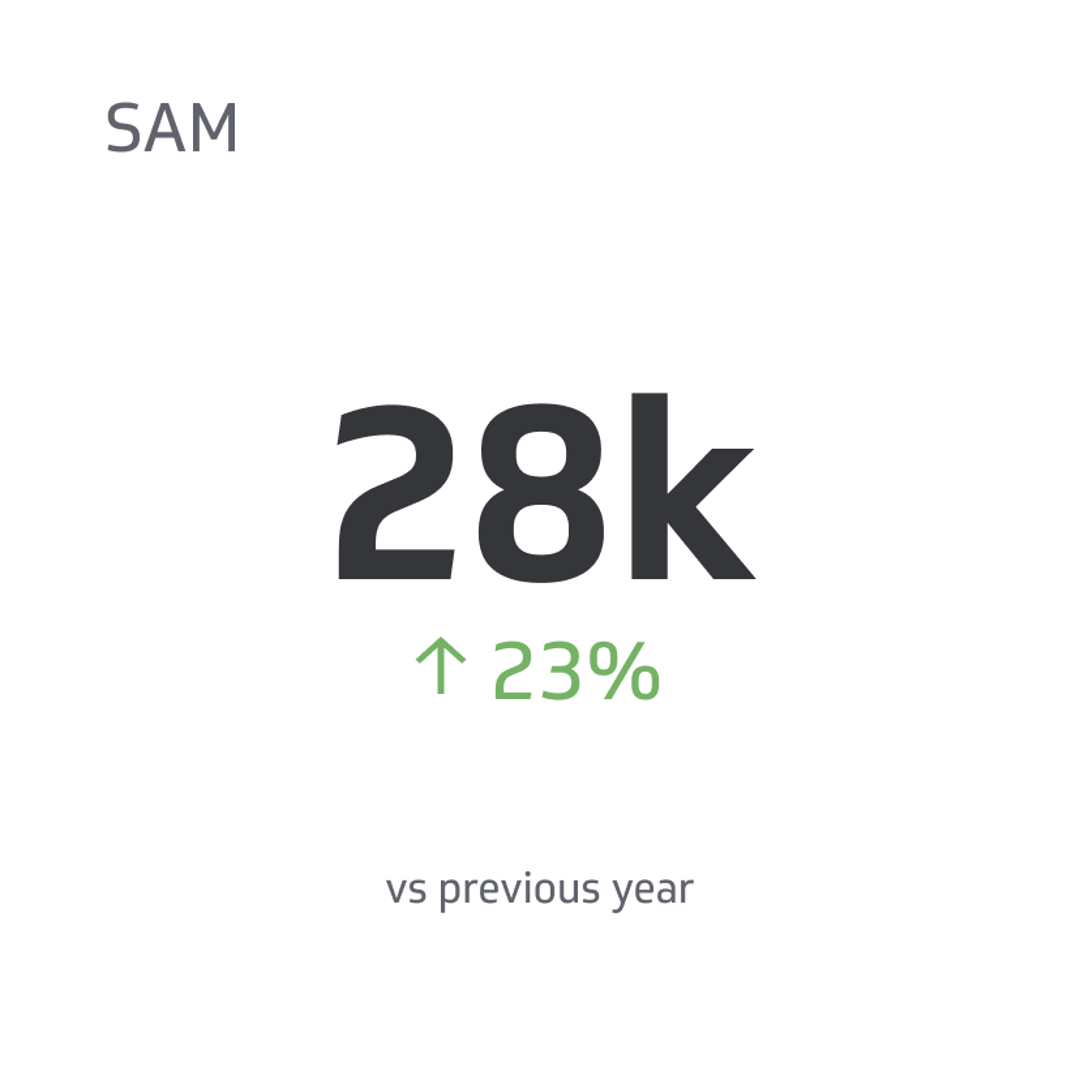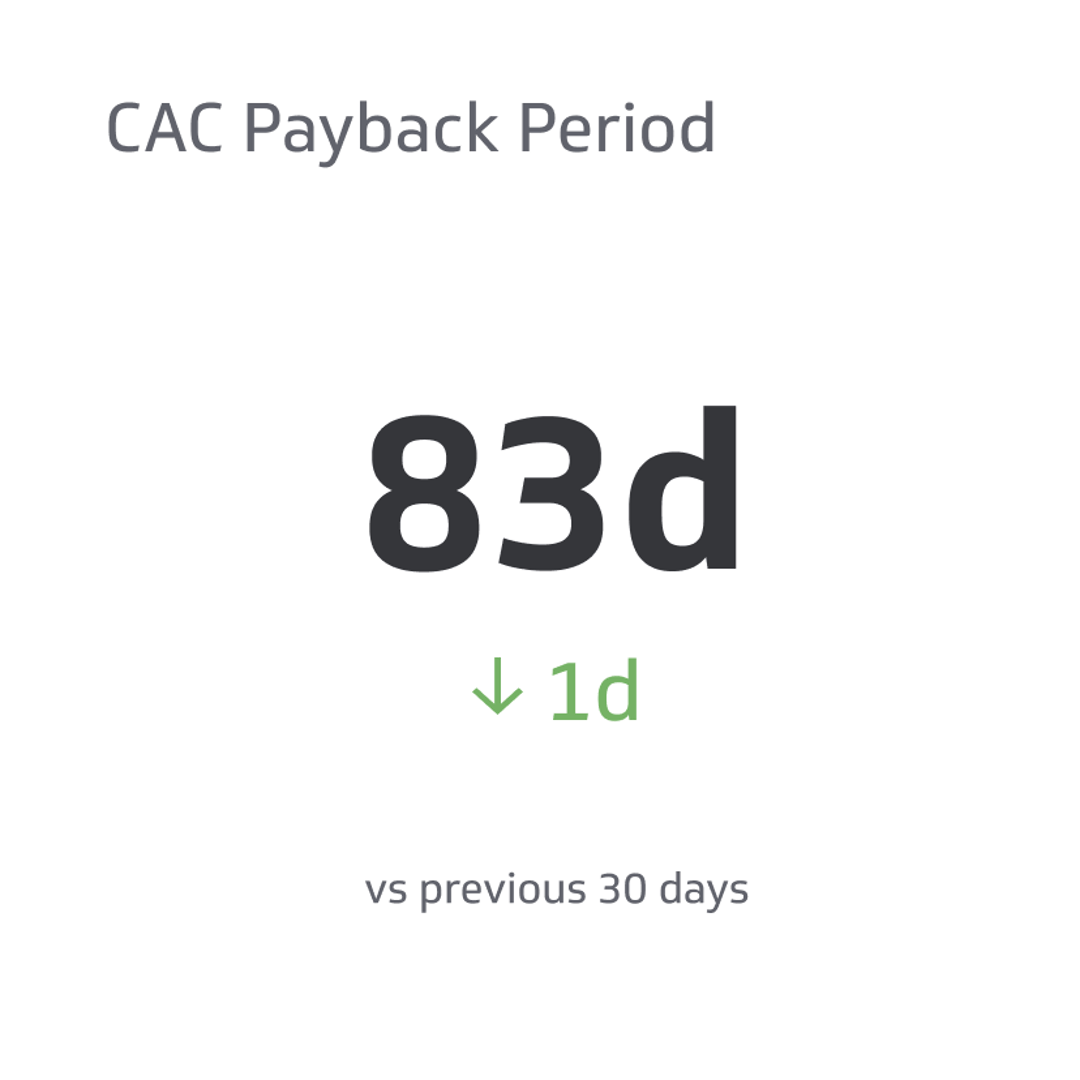Serviceable Addressable Market (SAM)
It's vital for a business to know the exact size and composition of SAM as it aids in the better allocation of resources.
Track all your SaaS KPIs in one place
Sign up for free and start making decisions for your business with confidence.

A Serviceable Addressable Market (SAM), also termed Serviceable Available Market, refers to the section of the Total Addressable Market (TAM) a business can reach with its business model.
A business can't capture 100% of a given market. Therefore, SAM defines a potential target market size a business can reach. For instance, when running a fast food chain, TAM represents the global fast food market. If a business had branches all over the world and there was no competition, then it would collect TAM as revenues.
However, this isn't realistic.
In the real business world, a business targets a specific customer base, which is the serviceable addressable market. The serviceable addressable market represents a fraction of the whole market a business can reach with its limited resources.
It's vital for a business to know the exact size and composition of SAM as it aids in the better allocation of resources. Effective allocation of resources helps a business to capture more leads and convert them into loyal, paying clients.
Calculating a Serviceable Addressable Market
To know a project's potential, it's important to analyze the market size. Investors are more interested in the market size as it helps them to understand how to narrow it down. For instance, if a company targets 1,000 customers in a market before narrowing down to a list of 20 - just 2% of their initial client base.
How does the business choose a few clients from a huge lot? The reality is that the business can't invest in all the clients. So, it has no option but to target a specific portion of the big market.
To do this, a business evaluates the total addressable market (TAM), serviceable addressable market (SAM), and service obtainable market (SOM).
What Is TAM?
As previously mentioned, TAM is the total market a business can reach with its products or services.
TAM is a valuable tool for investors as it provides estimates of the total revenue a business can generate and the market's scalability.
Since a business can't exist without competition, it's almost impossible to capture the exact figure of TAM.
What Is SOM?
While SAM is a submarket in TAM, Serviceable Obtainable Market (SOM) is a small section in SAM representing a market a business can realistically target, bearing in mind it has limited resources and it operates in a market with competing firms.
It's highly unlikely that a business startup will compete with big players in the industry from the get-go. Therefore, a SOM represents a realistic target market a business can reach and compete effectively within that small market.
Investors can either use a top-down or bottom-up approach to estimate TAM, SAM, and SOM. These two methods are briefly explained as follows.
Top-Down
The top-down analysis approach looks at the macroeconomic trends of the market and evaluates the percentage a business can target. To achieve this, investors depend on external market reports for their estimates.
Important areas to analyze include customers' demographic data, trends, trade balance, changes in GDP, surveys, energy consumption, and overall industry activity.
For the top-down analysis, investors would first analyze the international market before scaling down to evaluate the national market and other sub-sectors below it.
Bottom-Up
A bottom-up analysis works in complete reverse to the top-down estimation approach. To calculate TAM, SAM, and SOM, investors first look at the core business aspects, such as the number of clients, the number of products sold, the average price, etc. These figures will help investors to make informed decisions about the market as a whole.
Why Is SAM Important?
Whether you're running a big or small business, it's worth noting that your target market is more than just the number of potential customers you can target. Besides looking at how many people might find your products or services helpful, you must look at specific aspects of your niche that define the untapped segment in your market.
A serviceable addressable market is important for any business as it helps investors make financial projections and sound operation-related decisions. The idea of scaling down is crucial for investors and is one of the reasons they care about SAM. SAM offers a reasonable percentage of TAM the business can service.
Elements featured in SAM include the business location, market competition, economic status, and all other factors that could reduce the size of a given market into a manageable portion. While there are tons of factors that could affect SAM, investors should focus more on those specific to the industry.
Factors Affecting SAM
Below we cover multiple factors that affect SAM.
Population Size
The population size comprises the total number of potential buyers of a product/service and the total sales revenue the business can generate. Understanding the market size is of great importance for many reasons.
First, investors can determine how much profit they expect from investing in a specific market. From this, they can decide whether investing in the market is profitable.
If the investors opt to proceed with the investment, understanding the market size also helps develop a marketing strategy that suits the market. In this case, investors will develop practical marketing strategies addressing the unique needs of their potential customers.
Understanding the population size also helps to know how many people you need to hire in your team to service the market.
Product
The product's position in the marketplace will also affect the serviceable addressable market. Think about the product's growth potential and whether you can counter existing competition. It's also important to consider how customers perceive your products or services and how the demand might change.
Demographics
Besides looking at the population from a broad perspective, it's also important to define the buyer personas by looking at factors like gender, age, location, income, and education. Performing a demographic audience analysis helps investors develop effective marketing campaigns.
Demographic factors affect SAM as they determine how the business will reach its target market. If you're marketing your products or services to a younger population, you need to know their trigger points. The same applies to other customers your business wants to approach.
Competition
Evaluating the existing competition is also vital in determining how fast you can penetrate the market. If you're starting out, you'll first want to know your competitors' market share. Suppose there are big players in the market, and you stand no chance of winning over customers. In that case, you might consider differentiating your products or venturing into a new market altogether.
Typically, a critical evaluation of the competition will help you to make sound investment decisions about whether to invest in the market or not.
Examples of SAM
Reverting to the fast food chain business, if you want to introduce a new chain in a different city, you need to evaluate the new market. This means looking at factors like the existing demand for the product or service, demographics, and competition from similar ventures. If you realize that you're the only fast-food restaurant in the city, you'll generate revenues from SAM.
Say you want to establish a childcare center in a new city. Your serviceable addressable market would be the number of families demanding your services. These are young and old parents looking for after-school care services.
Using SAM Strategically
You now know that SAM helps SaaS businesses and investors to identify potential investment opportunities in a given market. What's more, SAM provides companies with valuable information on how to maximize their revenue potential.
When developing any SaaS business, it's essential to estimate SAM as this determines the likelihood of succeeding in the niche. For instance, paying more attention to interested prospects increases the chances of converting new clients into loyal customers and brand ambassadors.
Generally, proper use of serviceable addressable market data can make a huge difference in any business. Besides identifying potential market opportunities, a company can develop effective marketing strategies to grow in the market. Essentially, evaluating SAM data gives businesses valuable insights to invest wisely in a given market.
Related Metrics & KPIs


.png)
.png)